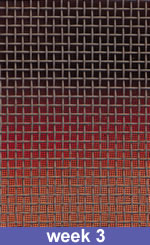WRITING FOR THE WEB
WRITING TIPS : GENERAL AND STRUCTURE
Below are thoughts and advice compiled from a workshop on writing for the web.
- Create a personality for the site - needs to be more personal
than print media.
- Think of the site map as a table of contents for a book and be
concise.
- General rule is to take print copy and cut it in half for the
web.
- Main ideas only.
- Results of eyetracker study done recently: Graphics catch
attention 30% of the time. Text caught attention more. Banner
ads get more attention than graphics on the page.
- Use headlines, sub-heads, key words bolded.
- Set sentences apart slightly.
- Make headings clear and concise - no teasers - make sure the
visitor knows exactly what they're going to get.
- Use pull quotes in different colour and font size to increase
interest in subject matter.
- Use casual tone - create a personality behind the site.
- Promotional text is too polished and not believable to people
reading on the web.
- Use inverted pyramid structure - start with conclusion first -
get to the point then explain in concise manner.
- Each product or service should have its own "genre" - decide
what that should be and tailor the writing to that audience.
WRITING TIPS : CONTENT
Be succinct and precise: As is well documented by Web usability studies, Web readers tend to skim over sites rather than read them intently. (It's hard on the eyes to read much on a computer monitor, and reading speed on a screen is on average 25% below reading ink on paper.) All your writing should be as tight as you can get it. The idea is to impart your message as quickly as possible, because you don't have much time.
Keep paragraphs and sentences short: Blocks of text on the Web should be no more than 75 words each and sentences kept short. Larger blocks of text make reading on-screen difficult, and you are more likely to lose readers.
Cut verbiage: Start out by writing chunks of text that are between 150 and 200 words. Then go after the chunks aggressively, with the aim of getting them down to around 55-60 words — where you'll have the luxury of adding a few words back in. Of what's left, "Every sentence, every phrase, every word has had to fight for its life,". "Pack the maximum meaning into the minimum text, so your readers will get the message in the shortest possible time."
Break long paragraphs into bullet lists: It is easier for those who scan Web pages to pick up your meaning; if the information is one long paragraph, it may not even get read.
Use strong verbs instead of weak ones: Write "Decide," not "Make a decision." Or "Use" instead of "Make use of." Not only does this technique present your message to Web readers more forcefully, but it takes fewer words.
Use the active voice: Use the active voice ("You made a serious mistake" versus the passive: "A serious mistake was made") in your Web writing. Using the active voice tends to take fewer words to say the same thing, and for Web readers who tend to skim rather than read, brevity is all-important.
Watch those extended metaphors: If you describe a government as a "ship of state" in one paragraph, and further in the story extend the metaphor to call the legislative branch the "engine room," that's a technique that's fine in print but doesn't work online. Web readers can skip around your content and enter an article at a middle point. If they encounter the latter part of that extended metaphor, they'll be left baffled.
Write and edit with international readers in mind: When writing for a Web site, remember that you may have an international audience. Readers in the U.S. will understand what a "fender bender" is, but those in other countries will be perplexed. Think before using distinctive words or phrases.
Print out to proofread: Print everything out on paper for final proofreading. You will catch more errors that way. Read your Web writing out loud — another technique for catching awkward phrasing that you might miss trying to proof your text on-screen.
RESOURCES
Writing for the Web [From Useit.com]How Users Read on the Web
Concise, SCANNABLE, and Objective:
How to Write for the Web



